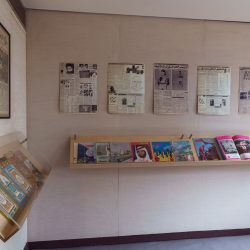IF WE WERE REALLY LIVING IN 2030 AND THE MINISTRY OF GRAPHIC WERE TO ACTUALLY BE ESTABLISHED, LET’S TOGETHER TRY TO IMAGINE THE ROLES AND RESPONSIBILITIES OF THE MINISTRY, WHAT DEPARTMENTS WOULD IT BE COMPRISED OF AND WHETHER SUCH IDEA COULD REALLY TAKE PLACE.
TEXT : SANTI LAWRACHAWEE
PHOTO COURTESY OF FIKRA EXCEPT AS NOTED
(For English please scroll down)
ท่ามกลางแดดและทรายร้อนระอุในเดือนพฤศจิกายน ห่างจากเทศกาล Dubai Design Week 2018 มาราวหนึ่งชั่วโมง อาคารร้าง 5 ชั้น ที่เคยเป็นธนาคารเก่าแก่ในเมืองซาร์จาห์ (Sharjah) ประเทศสหรัฐอาหรับเอมิเรตส์ ถูกปรับปรุงให้กลายเป็นกระทรวงการออกแบบกราฟิก โดยแต่ละชั้นถูกแปลงโฉมแยกส่วนเป็นแผนกต่างๆ ที่มีความสนใจเฉพาะ ทั้งในแง่ของประเด็นความคิด ช่วงเวลา และรูปแบบการนำเสนอแผนงาน ให้ผู้เข้ามาชมได้เข้าถึงแบบปลายเปิดและเกิดความคิดต่อ “การออกแบบกราฟิก” (อีกครั้ง)
Fikra Graphic Design Biennial จัดขึ้นปีแรกที่เมืองซาร์จาร์ภายใต้หัวข้อ “กระทรวงการออกแบบกราฟิก” ที่มีเป้าหมายในการนำเสนอการออกแบบกราฟิกในฐานะองค์ประกอบหลักของชีวิตร่วมสมัยผ่าน สื่อ ข้อความ การสื่อสารต่างๆ ที่เราพบเห็นอยู่ทุกวัน ทั้งนี้เพื่อสำรวจกฎเกณฑ์ แนวทางแก้ปัญหา ไปจนถึงการแลกเปลี่ยนความคิดเห็นในวงกว้าง แม้ปัจจุบันงานออกแบบกราฟิกจะได้รับความสนใจและการมีส่วนร่วมมากขึ้นอย่างต่อเนื่อง อันจะเห็นได้จากปริมาณการเข้าเรียนด้านการออกแบบที่สูงขึ้นทั่วโลก การสอดแทรกเข้าไปเป็นเครื่องมือทางธุรกิจของผู้ประกอบการทั่วโลก บทบาทต่อการสื่อสารเพื่อสาธารณะในหลายประเทศ องค์กรไม่หวังผลกำไร และหน่วยงานรัฐบาลต่างๆ ถึงกระนั้นการออกแบบกราฟิกก็ยังถูกมองเป็นเพียงเครื่องมือการโฆษณาที่ตั้งต้นจากไอเดียที่มีอยู่แล้ว ความคิดเหล่านี้แทบจะไม่ท้าทายหรือเปิดโอกาสให้กราฟิกได้ถูกตีความใหม่ ดังนั้นคำถามคือ จริงๆ แล้วอะไรคือความหมายและขอบเขตของการออกแบบกราฟิกในปัจจุบัน? และมันจะสามารถเป็นอะไรได้บ้างในอนาคต?

จากข้อมูลจากเว็บไซต์ของโครงการ Fikra Graphic Design Biennial 01 : Ministry of Graphic Design กระทรวงการออกแบบกราฟิกนี้ได้รับแรงบันดาลใจจากโครงสร้างรัฐบาลของประเทศสหรัฐอาหรับเอมิเรตส์ที่มีขนบการกำหนดบทบาทของกระทรวงแตกต่างจากประเทศอื่น เช่น กระทรวงแห่งความสุข หรือ กระทรวงปัญญาประดิษฐ์ ด้วยเหตุนี้กระทรวงการออกแบบกราฟิกจึงถูกสร้างขึ้นจากความคุ้นเคยที่มีต่อความเป็น “กระทรวง” โดยทำหน้าที่อำนวยความสะดวกในการทดลองและการพิจารณาเกี่ยวกับวงการการออกแบบที่ขยายวงกว้างขึ้นและผลกระทบต่อความคิดเห็นของสาธารณะ ผู้ประกอบการ วัฒนธรรม เทคโนโลยี และภาพรวมของสังคม
กระทรวงการออกแบบกราฟิกจึงเปรียบเหมือนเป็นโครงการเชิงอุดมคติ เริ่มจากการขยายภาพรวมของวงการออกแบบโดยพิจารณาถึงวิชาชีพ วัฒนธรรม และมุมมองแนวคิดต่างๆ เห็นได้ชัดว่าพยายามหนีจากคำนิยามตามกฎเกณฑ์ที่มีอยู่ รวมถึงการเข้าถึงโดยสื่อเฉพาะ หลายๆ กิจกรรมในเทศกาล Fikra Design Biennial ทำให้เราเห็นภาพว่าทุกวันนี้นักออกแบบต้องทำหน้าที่อย่างหนักหน่วงและแตกต่างมากมาย ไม่ว่าจะเป็นการพัฒนาผลประกอบการ การสร้างทั้งเนื้อหาและความหมาย การวางยุทธศาสตร์ การให้อัตลักษณ์ การบริหารและขยายโครงการ การวางแผนวัฏจักร รวมถึงการร่วมกำหนดนโยบายต่างๆ

Salem Al-Qassimi ผู้ก่อตั้ง Fikra และผู้อำนวยการของ Fikra Design Biennial กล่าวว่า “พวกเราตื่นเต้นและตั้งใจที่จะนำเสนองาน Graphic Design Biennial นานาชาติเป็นครั้งแรกในประเทศนี้เพื่อนักออกแบบอาชีพ และบุคคลทั่วไป (…) งานนี้มีเป้าหมายที่จะสื่อให้นักออกแบบเข้าใจความสำคัญของการออกแบบมากยิ่งขึ้น และที่สำคัญไปมากกว่านั้น ผมคิดว่ามันเป็นเรื่องสำคัญมากที่จะใส่และนำเสนอความเป็นชาติเอมิเรตส์ ลงไปในวาทกรรมที่เกี่ยวข้องกับการออกแบบกราฟิกทั่วโลกด้วย สำหรับเรามันเป็นเรื่องสำคัญพอๆ กันกับเรื่องอื่นๆ ที่จะสานต่อไอเดีย วัฒนธรรม และการเล่าเรื่องตามแบบฉบับของเราต่อไป”
Prem Krishnamurthy หนึ่งในผู้กำกับศิลป์ของงาน (Artistic Director) ได้เสริมว่า “กระทรวงการออกแบบกราฟิกได้นำเสนอว่าการออกแบบกราฟิกเป็นส่วนหนึ่งของชีวิตคน ที่เกิดจากสื่อกลาง ข้อความ และกระบวนการการสื่อสารมากมายที่เราต้องเผชิญอยู่ทุกวัน บางครั้งการออกแบบกราฟิกถูกมองว่าเป็นเพียงการสร้างภาพจากไอเดียที่มีอยู่เพื่อโฆษณา แต่ในความเป็นจริงมันถึงเวลาแล้วที่จะจัดกลุ่มและแจกแจงมุมมองใหม่ๆ เรากำลังสื่อสารความจริงจังผ่านการนำเสนอที่แฝงไปด้วยอารมณ์ขันท่ามกลางช่วงเวลาแห่งความวุ่นวายทั่วโลกในขณะนี้ และด้วยวิธีนี้การออกแบบกราฟิกจะถูกนำเสนอผ่านรูปแบบที่ไม่เป็นไปตามแบบแผน ตัวงานแสดงจะท้าทายการรับรู้ของสาธารณะที่มีต่อวงการออกแบบ รวมไปถึงการทดลองที่ก้าวข้ามขอบเขตขนบธรรมเนียมเดิมๆ เป้าหมายของเราก็เพื่อจะสร้างบทสนทนาว่าการออกแบบควรจะเป็นอย่างไรในอนาคต”
กระทรวงการออกแบบกราฟิกถูกแยกออกเป็นแผนกต่างๆ โดยแต่ละแผนกมีจุดสนใจและรูปแบบที่แตกต่างกัน แผนกเหล่านั้นประกอบไปด้วย
1. Department of Graphic Optimism
แผนกนี้ได้เสนอการเข้าถึงแบบสองระดับชั้นเพื่อทำความเข้าใจวัฒนธรรมของการแทนค่าด้วยภาพ และการเผยแพร่ผลิตผลต่างๆ ในระหว่างการพัฒนาของประเทศเอมิเรตส์ เริ่มจากการสำรวจค่านิยมและบทบาทของการสร้างภาพที่ถูกใช้วนไปวนมาในสิ่งพิมพ์ หนังสือพิมพ์ และสื่อต่างๆ ระหว่างปี 1970-1980 แสดงให้เห็นว่าค่านิยมเหล่านี้เป็นผลผลิตของวัฒนธรรมและการแลกเปลี่ยนองค์ความรู้กับผู้เดินทางที่หลั่งไหลเข้ามาทางอ่าว นอกจากนั้นยังมีการแสดงผลงานวาดของ Hisham Al Madhloum ในช่วงทศวรรษ 1980s-90s เขาเป็นนักออกแบบกราฟิกที่ทำงานเป็นผู้บริหารในสถาบันศิลปะและวัฒนธรรมต่างๆ มากมาย เป็นผลงานสร้างสรรค์ในช่วงต้นของประเทศสหรัฐอาหรับเอมิเรตส์ ในช่วงเวลาที่ศิลปิน กวี นักวาดภาพ นักเขียน และนักออกแบบได้ถูกมอบหมายให้ช่วยกันสร้างจิตวิญญาณและวัฒนธรรมของชาติ

2. Department of Dematerializing Language
การออกแบบกราฟิกสามารถปรับเปลี่ยนเนื้อหาที่สื่อสารได้อย่างทรงพลัง แต่มักจะเป็นกระบวนการที่ผู้คนมองไม่เห็น นั่นคือกระบวนการแปลงภาษาเป็นภาพ The Department of Dematerializing Language ได้ค้นหาวิธีที่จะปลดสื่อกลางนี้จากข้อจำกัดของการอ่านออก ความชัดเจน และรูปธรรมที่จับต้องได้ โดยนำเสนอวิธีการสื่อสารที่คาดไม่ถึง เมื่อธรรมชาติของภาษามักอยู่ในสภาพของเหลวและกำกวม งานที่ถูกนำเสนอในแผนกนี้จึงจะสะท้อนการแทนที่และความเป็นจริงของสังคม โดยการทดลองกับรูปทรงอย่างอิสระ ผลงานถูกกระจายไปทั่วตึกทั้งแบบเคลื่อนที่ได้และแบบวางอยู่กับที่ มันได้พิจารณาความเป็นไปได้ของการออกเสียง สัญศาสตร์ ระบบภาษา แหล่งข้อมูลของคำแปล และการมีส่วนร่วม เพื่อประกอบข้อความซับซ้อนให้ไปไกลกว่าการสื่อสารที่เกี่ยวข้องกับสัญลักษณ์และการได้ยินแบบตรงไปตรงมา
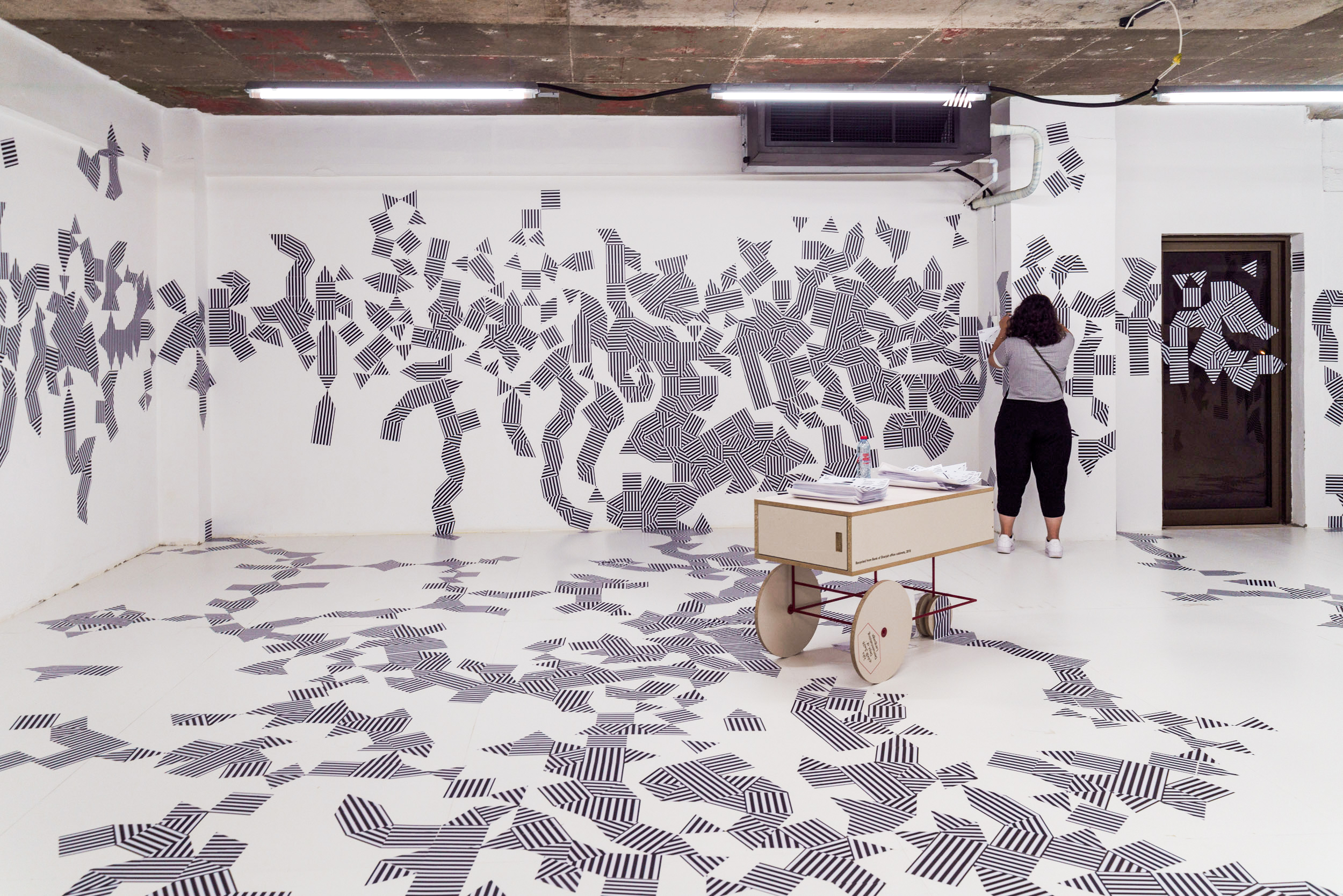
3. Department of Non-Binaries
จากเป้าหมายที่ต้องการปฏิเสธความเรียบง่ายและเปิดรับความซับซ้อนที่ช่วยสร้างพื้นผิวของการออกแบบกราฟิก วัฒนธรรม และอัตลักษณ์เฉพาะตัวของมนุษย์ในปัจจุบัน ทางแผนกได้เชิญนักปฏิบัติการที่ทำงานแบบผสมผสานมาอยู่รวมกัน ผลงานของพวกเขาทั้งอยู่ระหว่าง อยู่บนทางแยก หรือแม้กระทั่งอยู่บนจุดตัดของกฎระเบียบและวัฒนธรรม มันเป็นหลายๆ อย่างในเวลาเดียวกัน สิ่งที่รวมนักปฏิบัติที่มีความแตกต่างทางความคิดและวัฒนธรรมเหล่านี้เข้าด้วยกันคือวิธีการคิดและกระบวนการแบบนักออกแบบที่จำเป็นต้องปรับให้เข้ากันกับอำนาจของเครื่องมือการสื่อสาร และการยอมรับในโลกที่ถูกออกแบบมากขึ้น โดยสรุปแล้ว Department of Non-Binaries ไม่ได้เข้าใจการออกแบบในฐานะนามหรือกริยาแต่ในฐานะคำวิเศษณ์ การออกแบบจึงเป็นการจ้องมองหรือรูปแบบมากกว่าข้อบังคับ
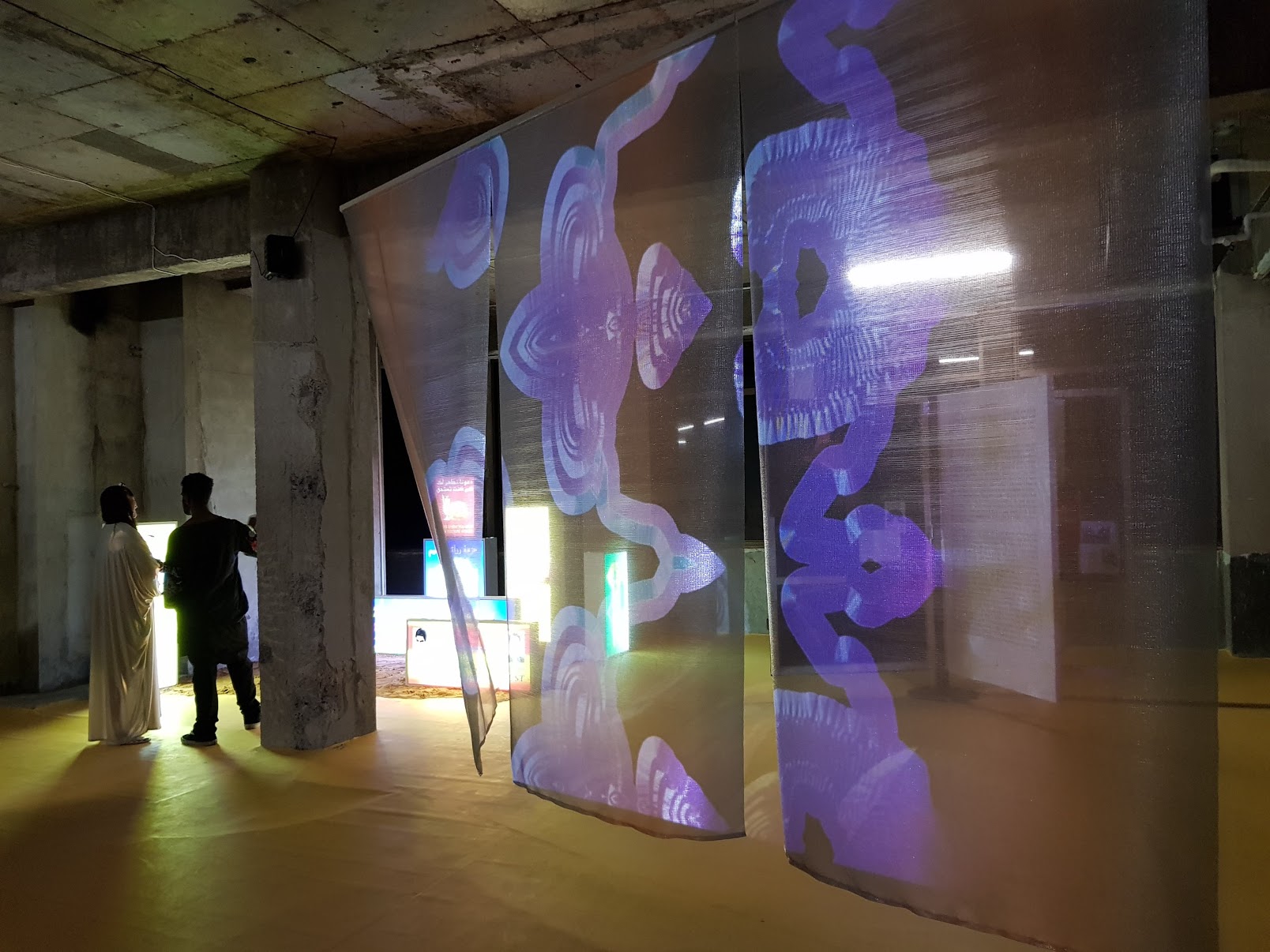
PHOTO: SANTI LAWRACHAWEE
4. The Department of Flying Saucers
พื้นที่เปิดสำหรับการนำเสนอสื่อใหม่ๆ โดยกลุ่มนักออกแบบอิสระ 4 กลุ่มที่มีแบคกราวน์การทำงานในพื้นที่ที่ต่างกันออกไป ไม่ว่าจะเป็น โอมาน อัมสเตอร์ดัม ไคโร ลอสแองเจลิส และโซล พวกเขามารวมตัวกันในซาร์จาห์ระยะสั้นๆ เพื่อเปลี่ยนแปลง “หลักการทำงาน” ผ่านกิจกรรมหลายๆ กิจกรรม ทั้งการทำงานร่วมกัน การบรรยาย งานสังสรรค์ และร้านค้าชั่วคราว ผลลัพธ์ครั้งนี้ออกมาเป็นวัตถุล่องลอยที่ไม่อาจระบุได้และเป็นเพียงส่วนย่อที่แทบไม่มีร่างที่เป็นรูปธรรม หากแต่ตื่นเต้น เร้าใจ และปลุกปั่น แทนที่จะนำเสนอข้อสรุป รูปแบบของการแสดงนี้กลับต้อนรับคลื่นของการตั้งคำถามด้วยวลี “ถ้าหาก…” ซึ่งก่อให้เกิดพายุทรายแห่งความเป็นไปได้ แผนกนี้จึงเปรียบได้กับความร้อนที่ทำให้ผู้พบเห็นรู้สึกแปลกตา ชั่วขณะ ลี้ลับ ประหลาด พิลึก ยากที่จะอธิบาย ตลก คลุมเครือ งุนงง น่าสงสัย บ้าบอ ไม่น่าเป็นไปได้ และไม่เหมือนอะไรที่เคยเห็นมาก่อน
5. Department of Mapping Margins
มีจุดมุ่งหมายในการทำให้อนาคตของ critical design ปรากฏขึ้น ท่ามกลางบรรยากาศการออกแบบกราฟิกที่ถูกควบคุมจากศูนย์กลาง ต้องยอมรับว่าภูมิทัศน์ของงานออกแบบในปัจจุบันค่อนข้างคับแคบ เพราะความแตกต่าง และความเฉพาะถิ่นถูกมองข้ามและผลักออกให้อยู่ในฐานะสิ่งที่ไม่เป็น “สากล” ไปเสียหมด แผนการปรับลดอิทธิพล “อาณานิคม” ด้านการออกแบบถูกจัดแสดงผ่านกิจกรรมอย่าง งานเลี้ยง การเดินสำรวจ การทำอาหาร การสนทนา และการทดลองการศึกษาที่ไร้รูปแบบ ทั้งหมดนี้เกิดขึ้นมาเพื่อสำรวจความเป็นไปได้ใหม่ๆ ของการออกแบบ ถึงแม้บางการสนทนาอาจจะเป็นการคาดเดา บางอันอาจจะช้าเนิบ บางอันเกิดขึ้นเพียงชั่วขณะ แต่ทั้งหมดล้วนเป็นส่วนประกอบของภาพรวม ทั้งนี้แน่นอนว่า The Department of Mapping Margins ไม่สามารถแก้ไข สร้างบรรทัดฐาน หรือเร่งสิ่งต่างๆ ได้ แต่มันจะสะท้อนวิธีมากมายที่อาจทำให้คนสัมผัสการออกแบบกราฟิก ในมุมต่างๆ ได้ไม่มีที่สิ้นสุด

6. The Office of the Archive (OofA)
แผนกลงพื้นที่เพื่อจัดเก็บวัตถุดิบและความรู้สึกที่เกิดขึ้นในเทศกาลให้เป็นหมวดหมู่ ทีม “The Absolute Beginners” (TAB) นั้นทำงานอยู่ในออฟฟิศเคลื่อนที่ บันทึกและจัดเก็บงานด้วยวิธีแบบสาธารณะและเชิงปฏิบัติ บทบาทของ Oofa ไม่ใช่การผลิตงานแสดง แต่เป็นการสร้างองค์ความรู้ที่จะช่วยให้ผู้คนในปัจจุบันและอนาคตเข้าใจ Fikra Graphic Design Biennal 01: Ministry of Graphic Design มากขึ้น และที่สำคัญเป้าหมายระยะสั้นกว่านั้นก็คือการเชื่อมผู้ชมภายในเทศกาลครั้งนี้ โดยใช้เครื่องมือทั่วไปอย่างโทรศัพท์มือถือ หรือกระทั่งกระดาษกับปากกา เพื่อนำผู้ชมเข้ามามีส่วนร่วมในกระบวนการจัดเก็บข้อมูล
จะเห็นได้ว่าแผนกต่างๆ เหล่านี้ได้นำเสนอทั้งวัตถุ ไอเดียความคิด การสนทนา การแสดง ผลงานจัดวาง และอื่นๆ อีกมากมาย แต่มากไปกว่านั้นคือมันได้เสนอการเข้าถึงการออกแบบกราฟิกแบบผสมผสานและมีพื้นผิวที่หลากหลายต่อประวัติศาสตร์ และการทำงานร่วมสมัย การออกแบบกราฟิกจะเป็นส่วนเติมเต็มในชีวิตร่วมสมัย ช่วยสร้างทุกๆ ข้อความและการสื่อสารที่เรามีส่วนร่วมอย่างชัดเจนและฝังลึกอยู่ในใจ ทั้งหมดนี้ทางโครงการได้รวบรวมและเชิญนักปฏิบัติที่ทำงานแบบผสมผสาน นักออกแบบอิสระ กลุ่มผู้เรียกร้องในประเด็นต่างๆ นักออกแบบหน้าใหม่ที่กระตือรือร้น และผู้คนที่ทำงานร่วมกับการออกแบบมากกว่า 40 คน โดยผู้เข้าร่วมงานเหล่านี้ได้ช่วยกันสร้างบริบทและสังคมผ่านงานอิสระ และงานที่ได้รับมอบหมายของพวกเขา ครอบคลุมเรื่องเล่าที่เร่งด่วน ระบบการทำงานร่วมกัน การเข้าถึงบนรากฐานการค้นคว้า การสะท้อนแนวคิด และการตีกรอบประวัติศาสตร์ใหม่ รวมถึงเสนอคุณค่าเฉพาะตัวของนักออกแบบกราฟิกในมุมมองแบบสหวิทยาการอีกด้วย
ด้วยผลงานและกิจกรรมมากมายในงานครั้งนี้ จึงขอส่งท้ายบทความด้วยการยกประเด็นจากเสวนาหัวข้อ Pedagogy and The Future of Design ในวันเปิดงาน ส่วนหนึ่งในกิจกรรมของ Department of Mapping Margins ซึ่งมีประเด็นน่าคิดสนุกๆ ที่วิทยากรท่านหนึ่งตั้งข้อสมมุติว่า หากเรากำลังอยู่ในปี 2030 แล้วกระทรวงการออกแบบกราฟิกเกิดขึ้นจริง และมีหน้าที่รับผิดชอบในการยกระดับประสิทธิภาพความคิดสร้างสรรค์ การวางแผนงาน และช่องทางการเรียนรู้ของคนในประเทศ วิทยากรท่านนั้นได้เสนอประเด็นคาดการณ์เชิงคำถามไว้ว่า…
– หากโรงเรียนแบบเดิมค่อยๆ เลือนหายไป
– หากเราทำงานแค่ปีละ 9 เดือน และอีก 3 เดือนเพื่อสำรวจการเรียนรู้ ความเคลื่อนไหว และความชำนาญ
– หากเราอยู่ในยุคที่กฎเกณท์ทางการออกแบบได้ตายไปแล้ว
– หากเราอยู่ในโลกที่ AI กลายเป็นอาจารย์และผู้ร่วมงานทางการออกแบบ
– หากเรามีกลุ่มนักคิดที่มีความหลากหลายและทั่วถึงในทุกระดับ เพศและวัยมากขึ้น
ในวันนั้น… เราน่าจะอยู่ในโลกที่ทุกคนเป็นนักออกแบบ ซึ่งบางครั้งทำให้รู้สึกว่าไม่มีใครเป็นนักออกแบบ อะไรคือความหมายของการเป็น D ตัวใหญ่ในโลกของนักคิดแบบนักออกแบบ (“D” Designer) ในเมื่อทุกคนทำได้แล้ว เราจะทำให้คนยอมรับได้อย่างไรว่าเรามีความสำคัญ นักออกแบบในอนาคตไม่ได้เป็นเหมือนผู้ยิงธนูที่สามารถยิงกลางเป้าหรือทำได้ดีเพียงอย่างเดียว แต่เราจะเป็น Slasher ด้วยมาตรฐานที่จะสับเปลี่ยนอยู่ 3 คุณสมบัติ คือ เราอยู่ในรูปแบบของการเรียนรู้ ความคล่องตัวกลมกล่อม และความเชี่ยวชาญ เมื่อเราจะแนะนำตัว เรานำเสนอ 3 คุณสมบัติเฉพาะตัวของเรา (ยกตัวอย่าง : ฉันเป็นนักออกแบบกราฟิก / นักมานุษวิทยา / นักร่างนโยบาย) ในวันนี้… เราจะสร้างมาตรฐานและโครงสร้างใหม่อย่างไร ที่จะช่วยเรียบเรียงความเป็นไปของวิชาชีพเพื่อปูทางให้แก่ความหลงใหล โดยมีจุดพักระหว่างทางเพื่อให้ได้เรียนรู้ สัมผัสความกลมกล่อมของสิ่งที่ทำ และฝึกฝนความชำนาญให้ประณีต
ความเชื่อที่ว่า…
การออกแบบสามารถกอบกู้โลกได้
การออกแบบเป็นการฝึกฝนบนพื้นฐานของบริบท
การออกแบบสร้างรูปร่างให้ทุกสิ่ง
การออกแบบไม่ได้ใหญ่ไปกว่าชีวิต แต่มันเป็นสิ่งที่เรามีส่วนร่วมในชีวิตประจำวัน
การออกแบบไม่ได้มีแค่ทางแก้ปัญหาแค่ทางเดียว แต่มีความเป็นไปได้มากมาย
การออกแบบจึงควรต้องถูกขยายให้กว้าง เพื่อส่งต่อคำถามสำคัญต่อไปเรื่อยๆ ว่าอะไรคือการออกแบบกันแน่
“พรุ่งนี้” และ “อนาคต” จึงไม่ใช่คำยิ่งใหญ่เอาไว้ประโคมให้ตื่นตระหนกและถากถาง หากแต่เป็นได้ตั้งแต่นาทีถัดไปหรือวันถัดไปเช่นกัน การคิดถึงอนาคต ทำให้ต้องสำรวจอดีต พิจารณาปัจจุบัน
การออกแบบล้วนเกี่ยวข้องกับอนาคต นักออกแบบล้วนแล้วแต่วางแผนให้เกิดอนาคตที่ตั้งใจไว้ตามเป้าประสงค์ การออกแบบจึงเกี่ยวพันกับอนาคตอย่างแยกไม่ได้งาน Fikra Graphic Desig Biennale ครั้งนี้จึงทำให้ตระหนักถึงความเป็นไปได้ ณ ตอนนี้ จากคำถามที่ว่า “เราจะออกแบบอนาคตความเป็นนักออกแบบของเราอย่างไร ?”
 In the midst of the burning sun and desert of November, about one hour from the site of Dubai Design Week 2018, a five story abandoned building that was once a long-standing bank in the city of Sharjah, United Arab Emirates, is turned into the Ministry of Graphic Design. Each story is vamped up to accommodate different departments, encompassing various concepts, issues, time periods and presentational styles as viewers are given access to open-end possibilities surrounding ‘graphic design’.
In the midst of the burning sun and desert of November, about one hour from the site of Dubai Design Week 2018, a five story abandoned building that was once a long-standing bank in the city of Sharjah, United Arab Emirates, is turned into the Ministry of Graphic Design. Each story is vamped up to accommodate different departments, encompassing various concepts, issues, time periods and presentational styles as viewers are given access to open-end possibilities surrounding ‘graphic design’.
Fikra Graphic Design Biennial is held for the first time in Sharjah. Themed ‘Ministry of Graphic Design’, the event aims to present graphic design as a major element of contemporary life through media, messages, means of communication we encounter on a daily basis, in order to explore the rules and solutions as well as the exchange of opinions in a larger scale. Graphic design has been increasingly recognized and engaged in, proven by the number of students enrolled in graphic design courses all over the world and the role of the discipline as a business tool of entrepreneurs worldwide not to mention the way graphic design has been used as a public communication tool in several countries whether by non-profit organizations or governmental agencies. But even all of the aforementioned, graphic design has been viewed merely as an advertising apparatus originated from the already existing ideas. Such mindset barely challenges or offers a chance for graphic design to be reinterpreted, so the real question here is more about what is the meaning and boundary of graphic design today and what can it become in the future?

From information included its official website, the idea for Fikra Graphic Design Biennial 01 : Ministry of Graphic Design is inspired by the distinctive governmental structure within the United Arab Emirates such as the Minister of State for Happiness and Wellbeing and the Minister of State for Artificial Intelligence. The Ministry of Graphic is, therefore, formed from the idea people have for a ministry as its role in facilitating experimental thinking about the “expanded field of graphic design and its impact on public opinion, entrepreneurship, culture, technology, and society-at-large”.
The Ministry of Graphic serves as an ideal project that begins with the broadened perception towards the design industry with consideration in the professional practice, culture, point of views and opinions. Clearly, it is an attempt to escape from the existing definitions and norms, particularly the access to certain specific media. Several activities in this festival help paint a better picture of the intensifying and diverse roles and responsibilities that designers are carrying on their shoulders whether it’s the development of turnover, contents and meaning, strategy planning, identity formation, project management and expansion all the way to cycle planning and policy formulation.
“We are excited to launch this first-of-its-kind international graphic design biennial in the region. We envisaged creating a graphic design biennial for both professionals and the general public alike,” said Salem Al-Qassimi, Founder and Principal of Fikra, and Director of the Fikra Graphic Design Biennial. “The event aims to communicate the importance of graphic design as a practice and help designers understand it better. More importantly, I think that it is crucial to have a representation of this region in the discourse related to graphic design practice across the globe. It is equally important for us to carry forward our ideas, culture, and narrative.”
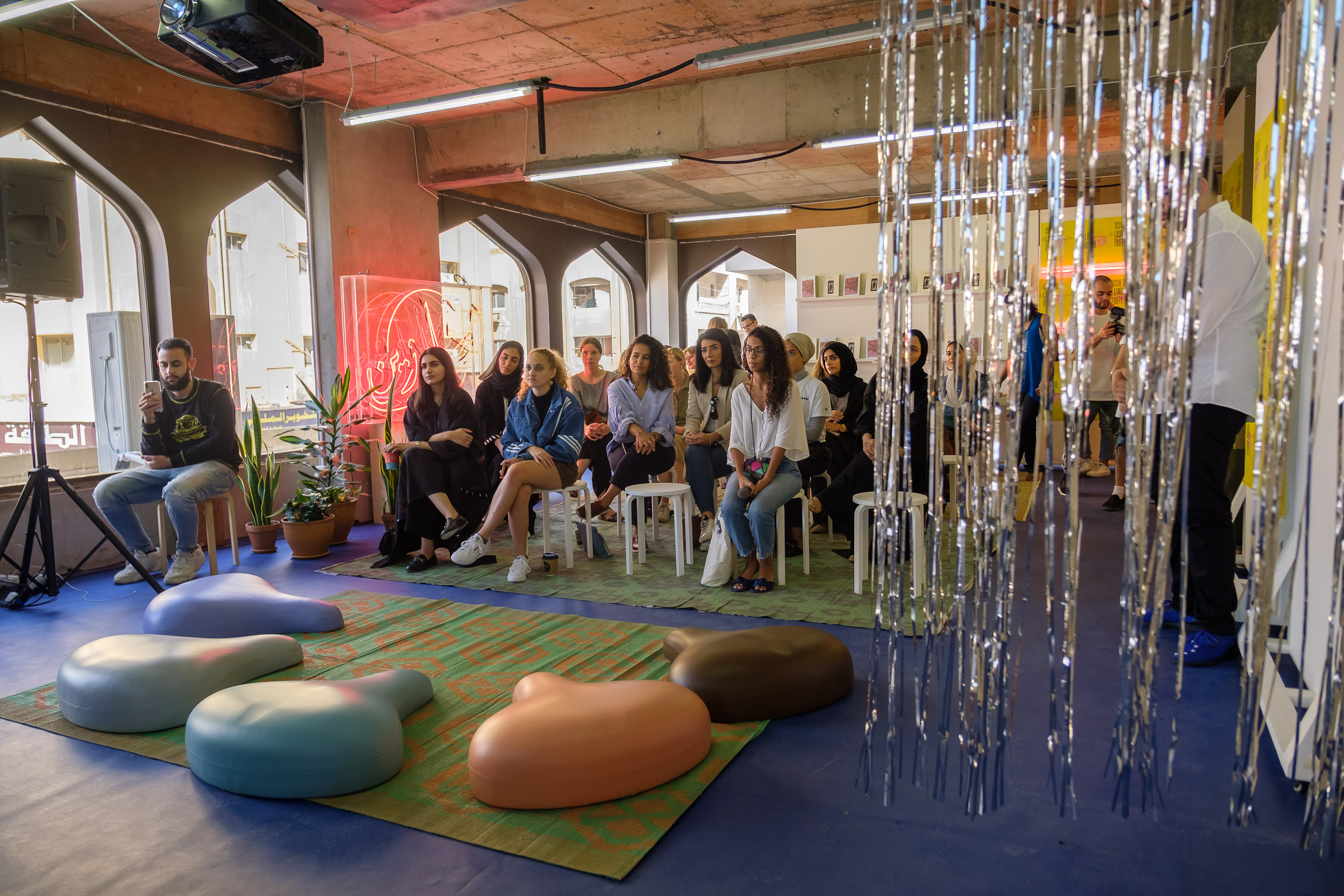
Prem Krishnamurthy, as one of the event’s Artistic Directors, further commented that “Fikra Graphic Design Biennial 01: Ministry of Graphic Design proposes graphic design as integral to contemporary civic life, forming nearly every medium, message, and communication we encounter today. While graphic design is sometimes overlooked as the mere commercial production of visual surfaces for existing ideas, in reality, it is a timely medium for catalyzing new approaches. Intended seriously yet inflected by a tongue-in-cheek approach, the theme presents graphic design in familiar and unconventional formats. During this moment of global turbulence, the exhibition challenges the public perception of the field and experiments beyond accepted disciplinary boundaries. Our goal is to start a dialogue around what graphic design could accomplish tomorrow.”
The Ministry of Graphic Design is divided into following different departments, with each department focusing and operating with its own interests and formats.
1.Department of Graphic Optimism
The department proposes two levels of access in order to understand the visual representation culture and distribution of the produced works throughout the development of United Arab Emirates. It starts with a survey on the norms and role of visual production and the reuse of visuals in print media, newspaper and other types of media between 1970s and 1980s. It illustrates how such values are the products of the interconnected cultures and exchange of body of knowledge by the people who migrated through the gulf. The Department of Graphic Optimism also showcases the 1980s-90s works by Hisham Al Madhloum, the graphic designer who works as executives for a great number of art and cultural institutes. His works mark the early days of United Arab Emirates when artists, poets, painters, writers and designers were assigned to build the nation’s spirit and culture.
2.Department of Dematerializing Language
Graphic design can powerfully transform a communicated message, but it is often an invisible process of visualizing languages. The Department of Dematerializing Language searches for ways to discharge this medium from the constraints of legibility, clarity, and physical tangibility by introducing unexpected modes of communication. With languages often fluid and ambiguous, the works presented by this department reflect a shifting, social reality by experimenting freely with form. Works are scattered throughout the building, some are mobile while some are installed in specific locations. They contemplate the potential of phonetics, semiotics, language systems, crowd-sourced translations, and participatory engagement to create complex messages that resonate beyond straightforward signal-and-sound relations.

3.Department of Non-Binaries
The rejection of simplicity and openness to complexity that facilitates layers in graphic design, culture and specific identity of today’s people, the department brings interdisciplinary practitioners together with their works situating in between or on the crossroad where rules and cultures intersect. These works are many things at the same time. What brings practitioners of such diverse ideological and cultural background together is the thinking method and design process, which need to be adjusted to correspond with the power of communication tool and acceptance in the world that has been designed. The Department of Non-Binaries, therefore, does not try to comprehend design as a noun or a verb but as an adverb. And with that, design becomes more of a gaze or format rather than a set of rules.

PHOTO: SANTI LAWRACHAWEE
4.The Department of Flying Saucers
An open space for temporary presentations by 4 independent design initiatives with diverse professional backgrounds working in place Oman, Amsterdam, Cairo, Los Angeles and Seoul. They come together in Sharjah for a brief period to transform the platform through activities such as workshops, lectures, parties, pop-up shops, and more. The result is an unidentified flying object; an exhibition too brief with no tangible form yet surprising, exhilarating, and provocative. Instead of presenting a conclusion, the format of the show welcomes waves of the ‘what if’ questions, and builds a desert storm of possibility. The department can be compared to the heat that that brings ‘the anomalous, the unfamiliar, the temporal, the mysterious, the peculiar, the queer, the inexplicable, the uncanny, the funny, the obscure, the puzzling, the bewildering, the crazy, the unbelievable, the unlike-anything-else-you-have-ever-witnessed-before.’
5.Department of Mapping Margins
It aims to bring forth the future of critical design in the midst of the (strictly) controlled graphic design climate moderated by the center. The rather constrained landscape of design is something to be admitted while local identities are being neglected and dismissed as ‘un-universal’. The plan is to provide strategies to de-center and de-colonize disciplinary lines of control through activities such as communal feasts, conversations, cooking, walking tour and pedagogical experiments. All the activities are designed to explore new possibilities of design. While some dialogues are speculative, some are slow, some take place only temporarily, yet each is part of the whole (a draft, perhaps). The Department of Mapping Margins cannot be fixed, normative or fast, but it will reflects many possible ways that can enable people to experience graphic design in indefinite aspects.

6.The Office of the Archive (OofA)
The Office of the Archive (OofA) is an on-site archiving office that collects and indexes artifacts and impressions of the biennial. “The absolute Beginners”(TAB) is a team of archivists works in a mobile office to document and archive the Biennial in a public and performative manner. The role of Oofa isn’t to produce an exhibition but building a body of knowledge that will allow people of the present and the future to better understand Fikra Graphic Design Biennial 01: Ministry of Graphic Design. More importantly, its short-term goal is to connect viewers of the festival using ordinary tools such as smartphones, or even paper and pen, enabling them to take part in the archiving process.
While viewers witness their presentations of objects, ideas, conversations, performances, installations and so on, what these departments bring forward is the mixed access to graphic design with multiple layers of history and contemporary approaches to the practice. Graphic design serves as an element that fulfills the contemporary life, helping us facilitating messages and communication that we visibly take part in and are hidden deeper in our heart. The project brings together and invites over 40 interdisciplinary practitioners, independent designers, advocates, enthusiastic new face designers and people who have been collaborating with the design industry. These participants will contribute to the development of context and society through their independent and commissioned projects, which encompass fast-paced narratives, collaborative system, accessibility based on research, conceptual reflection and reframing of history, including the presentation of the values of graphic designers from the interdisciplinary aspect.
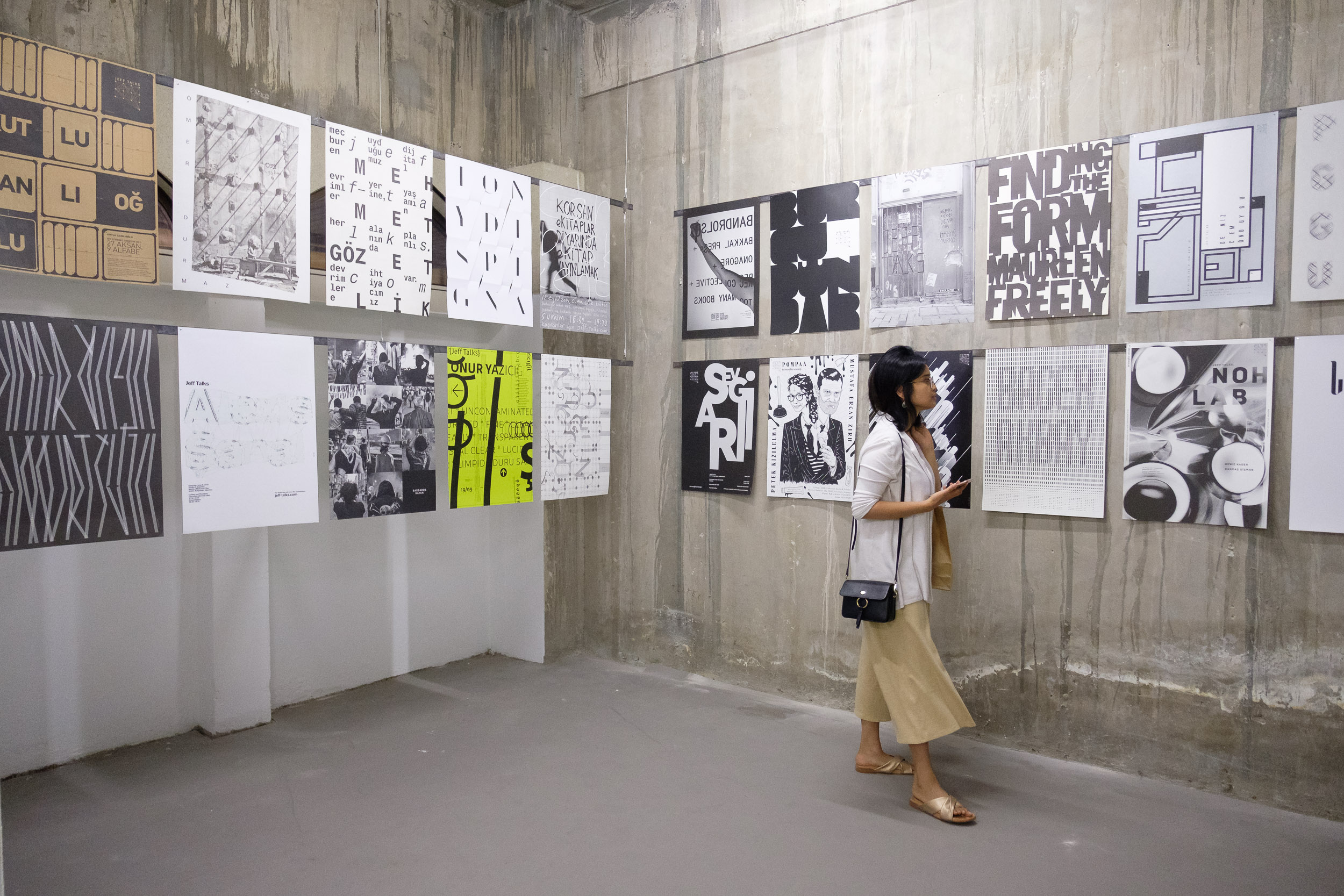
With such vast number of works and activities, we would like to conclude this article with the Pedagogy and The Future of Design topic discussed at the talk held on the first day of the event as a part of the Department of Mapping Margins’ activities. The talk raises some fun discussions with one of the speakers drawing interesting hypotheses that if we were living in the year 2030 and the Ministry of Graphic Design were to really exist with responsibilities encompassing the elevation the efficiency of creativity, strategy formulation and learning channels for the country’s population, the speculative questions would likely be…
– What if conventional schools were to disappear?
– What if we worked only 9 months of the year and spent the other 3 months exploring our learning ability, proficiency and movement?
– What if we were living in the time when the rules and principles of design no longer existed?
– What if we live in the world where AI becomes are teachers and design collaborators?
– What if we were to have a variety of thinkers with diverse initiatives from all backgrounds, age groups and genders?

If the day came, we would be living in the world where everyone is a designer, which could also mean that would be no designer at all. What’s the meaning of the capital D in the world of thinkers and designers? If everyone can all do it, how can we make people recognize and accept our significance? Designers of the future are not someone who can hit the arrow right at the bull’s eye but rather a slasher with three interchangeable standards: learning, mobility and proficiency. When we introduce ourselves, it will include three of our best qualities (for example: I’m a graphic designer/anthropologist/policy formulator). How can we create a new standard and structure that will help arrange the trajectory of our profession, allowing our passion to prosper with stops along the way for us to take a break and learn, experience what we have done and accomplished and perfect our craft.
The beliefs that…
Design can save the world
Design is a training based on contexts
Design gives forms to all things
Design isn’t larger than life but a part of life
Design doesn’t offer only one solution but countless possibilities
Design should be broadened in order to keep passing on the important question—what really is design?
Tomorrow and the future are not these great words used for provocation and satire, but just implications of the next minute or the next day. Thinking about future, we are forced to explore the past and contemplate the present. Design is all associated to the futures and designers are all planning for the kind of future they wish to see. Design and the future are, therefore, not only related but also inseparable. This Fikra Graphic Design Biennale brings us to realize the possibility of the moment from the question “How can we design our future traits as designers?”
fikrabiennial.com


